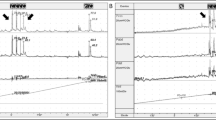Abstract
Stress urinary incontinence (SUI) is a major health issue that affects millions of patients each year. Traditionally, surgical procedures such as slings or bladder neck suspension were the only options to treat this condition. In recent years, multiple minimally invasive options to treat SUI were introduced into the market. These include bulking agents, injection of stem cells into the rhabdosphincter, and adjustable continence therapy devices. These procedures are simple, minimally invasive, and well tolerated by patients. This article reviews the benefits, efficiency, side effects, and complications of these minimally invasive methods for treatment of SUI.
Similar content being viewed by others
References and Recommended Reading
Murless BC: The injection treatment of stress incontinence. Brit J Obst Gynaec 1938, 45:67.
Berg S: Polytef augmentation urethroplasty. Correction of surgically incurable urinary incontinence by injection technique. Arch Surg 1973, 107:379.
Politano VA, Small MP, Harper JM, et al.: Periurethral teflon injection for urinary incontinence. J Urol 1974, 111:180.
Shortliffe LMD, Freiha FS, Kessler R, et al.: Treatment of urinary incontinence by the periurethral implantation of glutaraldehyde cross-linked collagen. J Urol 1989, 141:538.
O’Connell HE, McGuire EJ, Aboseif S, et al.: Transurethral collagen therapy in women. J Urol 1995, 154:1463–1465.
Smith DN, Appell RA, Winters JC, et al.: Collagen injection therapy for female intrinsic sphincteric deficiency. J Urol 1997, 157:1275–1278.
Lightner D, Calvosa C, Anderson R, et al.: A new injectable bulking agent for treatment of stress urinary incontinence: results of a multicenter, randomized, controlled, doubleblinded study of Durasphere. Urology 2001, 58:12–15.
Appell RA, Dmochowski RR, Herschorn S: Urethral injection for female stress incontinence. BJU Int 2006, 98:27–30.
Anderson RC: Long term follow-up comparison of durasphere and contigen in the treatment of stress urinary incontinence. J Low Genit Tract Dis 2002, 6:239–243.
Pannek J, Brands FH, Senge T: Particle migration after transurethral injection of carbon coated beads for stress urinary incontinence. J Urol 2001, 166:1350–1353.
Ritts RE: Particle migration after transurethral injection of carbon coated beads. J Urol 2002, 167:1804–1805.
Chrouser KL, Fick F, Goel A, et al.: Carbon coated zirconium beads in beta-glucan gel and bovine glutaraldehyde cross-linked collagen injections for intrinsic sphincter deficiency: continence and satisfaction after extended follow up. J Urol 2004, 171:1152–1155.
Ghoniem G, Corcos J, Comiter C, et al.: Cross linked polydimethylsiloxane injection for female stress urinary incontinence: results of a multicenter, randomized, controlled, single blind study. J Urol 2009, 181:204–210.
Tamanini JT, D’Ancona CA, Netto NR: Macroplastique implantation system for female stress urinary incontinence: long term follow-up. J Endourol 2006, 20:1082–1086.
Henly DR, Barrett DM, Weiland TL, et al.: Particulate silicone for use in periurethral injections: local tissue effects and search for migration. J Urol 1995, 153:2039–2043.
US Food and Drug Administration: Summary of safety and effectiveness data. Macroplastique implants, P040050. Available at http://www.fda.gov/MedicalDevices/ProductsandMedicalProcedures/DeviceApprovalsand-Clearances/Recently-ApprovedDevices/ucm077408.htm. Accessed March 2009.
Dmochowski R, Appell RA, Limberg I, et al.: Initial clinical results from coaptite injection for stress urinary incontinence, comparative clinical study. Presented at the International Continence Society. Heidenberg, Germany; August 2002.
Palma PC, Riccetto CL, Martins MH, et al.: Massive prolapse of the urethral mucosa following periurethral injection of calcium hydroxylapatite for stress urinary incontinence. Int Urogynecol J Pelvic Floor Dysfunct 2006, 17:670–671.
Lose G, Mouritsen L, Nielsen JB: A new bulking agent (polyacrylamide hydrogel) for treating stress urinary incontinence in women. BJU Int 2006, 98:100–104.
A new bulking agent (Bulkamid) for treating female stress incontinence: retrospective 9-24 months follow-up [no authors listed]. Presented at the XXIII NUGA Congress 2007. Helsinki, Finland; January 19–20, 2007.
Bent AE, Tutrone RT, McLennan MT, et al.: Treatment of intrinsic sphincter deficiency using autologous ear chondrocytes as a bulking agent. Neurourol Urodyn 2001, 20:157–165.
Oberpenning F, Meng J, Yoo JJ, et al.: De novo reconstitution of a functional mammalian urinary bladder by tissue engineering. Nat Biotechnol 1999, 17:149–155.
Smaldone MC, Chen ML, Chancellor MB: Stem cell therapy for urethral sphincter regeneration. Minerva Urol Nefrol 2009, 61:27–40.
Kwon D, Kim Y, Pruchnic R, et al.: Periurethral cellular injection: comparison of muscle derived progenitor cells and fibroblasts with regard to efficacy and tissue contractility in an animal model of stress urinary incontinence. Urology 2006, 68:449–454.
Burdzinska A, Paczek L: Myogenic stem cells: the new material for periurethral injections in the treatment of urinary incontinence [in Polish]. Przegl Lek 2008, 65:362–366.
Mitterberger M, Marksteiner R, Margreiter E, et al.: Autologous myoblasts and fibroblasts for female stress incontinence: a 1-year follow-up in 123 patients. BJU Int 2007, 100:1081–1085.
Mitterberger M, Pinggera GM, Marksteiner R, et al.: Adult stem cell therapy for female stress urinary incontinence. Eur Urol 2008, 53:169–175.
Sousa-Escandon A, Lema GJ, Rodrigues Gomez JI, et al.: Externally readjustable device to regulate sling tension in stress urinary incontinence: preliminary results. J Endourol 2003, 17:515–521.
Palma CRP, Dambros M, Riccetto CZ, et al.: The Ibero-American experience with a re-adjustable minimally invasive sling. BJU Int 2005, 95:341–345.
Amaye-Obu FA, Drutz HP: Surgical management of recurrent stress urinary incontinence: a 12 year experience. Am J Obstet Gynecol 1999, 1296–1307.
Aboseif RA, Franke EI, Nash SD, et al.: The Adjustable Continence Therapy (ACT) system: one year results of the North America clinical study group. J Urol 2009 (in press).
Kocjancic E, Crivellaro S, Smith JJ, et al.: Adjustable continence therapy for treatment of recurrent female urinary incontinence. J Endourol 2008, 22:1403–1407.
Author information
Authors and Affiliations
Corresponding author
Rights and permissions
About this article
Cite this article
Sassani, P., Aboseif, S.R. Stress urinary incontinence in women. Curr Urol Rep 10, 333–337 (2009). https://doi.org/10.1007/s11934-009-0052-5
Published:
Issue Date:
DOI: https://doi.org/10.1007/s11934-009-0052-5




